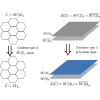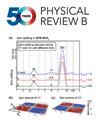Anyon condensation in string-net models
IF 3.7
2区 物理与天体物理
Q1 Physics and Astronomy
引用次数: 0
Abstract
We study the condensation of Abelian bosons in string-net models by constructing a family of Hamiltonians that can be tuned through any such transition. We show that these Hamiltonians admit two exactly solvable, string-net limits: one deep in the uncondensed phase, described by an initial, uncondensed string-net Hamiltonian, and one deep in the condensed phase, described by a final, condensed string-net model. We give a systematic description of the condensed string-net model in terms of the uncondensed string-net and the data associated with the condensing Abelian bosons. Specifically, if the uncondensed string-net is described by a fusion category , we show how the string labels and fusion data of the fusion category describing the condensed string-net can be obtained from that of and the data describing the string operators that create the condensing boson. This construction generalizes previous approaches to anyon condensation in string-nets by allowing the condensation of arbitrary Abelian bosons, including chiral bosons in string-nets constructed from, for example, Chern-Simons theories, which describe time-reversal invariant bilayer states. This gives a method for obtaining the full data for string-nets without explicit time-reversal symmetry from such bilayer models. We illustrate our approach with several examples.

弦网模型中的安永冷凝
我们研究了弦网模型中阿贝尔玻色子的凝结,构建了一系列可以通过任何这种转变进行调整的哈密顿。我们证明,这些哈密顿斯包含两个完全可解的弦网极限:一个深入非凝聚阶段,由初始非凝聚弦网哈密顿斯描述;另一个深入凝聚阶段,由最终凝聚弦网模型描述。我们根据非凝聚弦网和与凝聚阿贝尔玻色子相关的数据,对凝聚弦网模型进行了系统描述。具体地说,如果非凝聚弦网是由融合范畴C描述的,我们展示了描述凝聚弦网的融合范畴C̃的弦标签和融合数据是如何从C和描述产生凝聚玻色子的弦算子的数据中获得的。这种构造概括了以往在弦网中凝聚任意子的方法,允许凝聚任意阿贝尔玻色子,包括在弦网中凝聚手性玻色子,例如由描述时间反转不变双层态的切尔-西蒙斯理论构造的弦网。这就提供了一种方法,可以从这类双层模型中获得没有明确时间反转对称性的弦网的全部数据。我们用几个例子来说明我们的方法。
本文章由计算机程序翻译,如有差异,请以英文原文为准。
求助全文
约1分钟内获得全文
求助全文
来源期刊

Physical Review B
物理-物理:凝聚态物理
CiteScore
6.70
自引率
32.40%
发文量
0
审稿时长
3.0 months
期刊介绍:
Physical Review B (PRB) is the world’s largest dedicated physics journal, publishing approximately 100 new, high-quality papers each week. The most highly cited journal in condensed matter physics, PRB provides outstanding depth and breadth of coverage, combined with unrivaled context and background for ongoing research by scientists worldwide.
PRB covers the full range of condensed matter, materials physics, and related subfields, including:
-Structure and phase transitions
-Ferroelectrics and multiferroics
-Disordered systems and alloys
-Magnetism
-Superconductivity
-Electronic structure, photonics, and metamaterials
-Semiconductors and mesoscopic systems
-Surfaces, nanoscience, and two-dimensional materials
-Topological states of matter
 求助内容:
求助内容: 应助结果提醒方式:
应助结果提醒方式:


